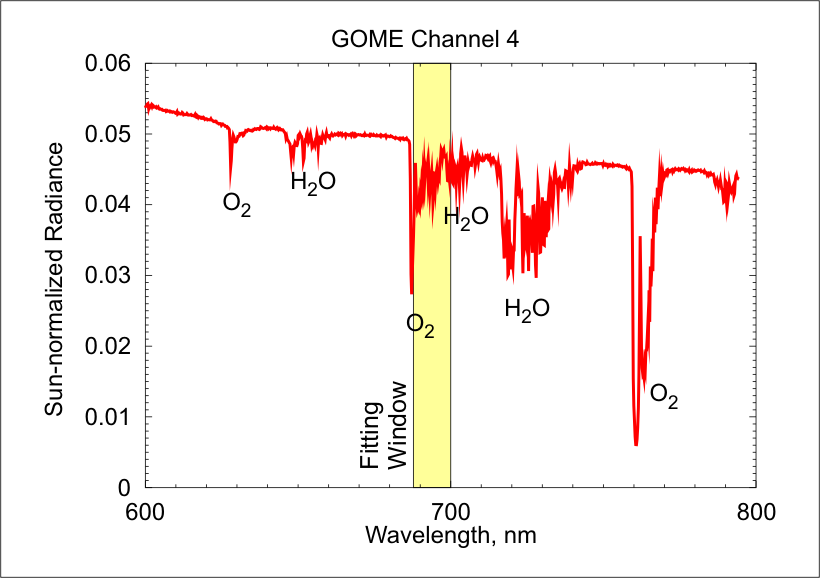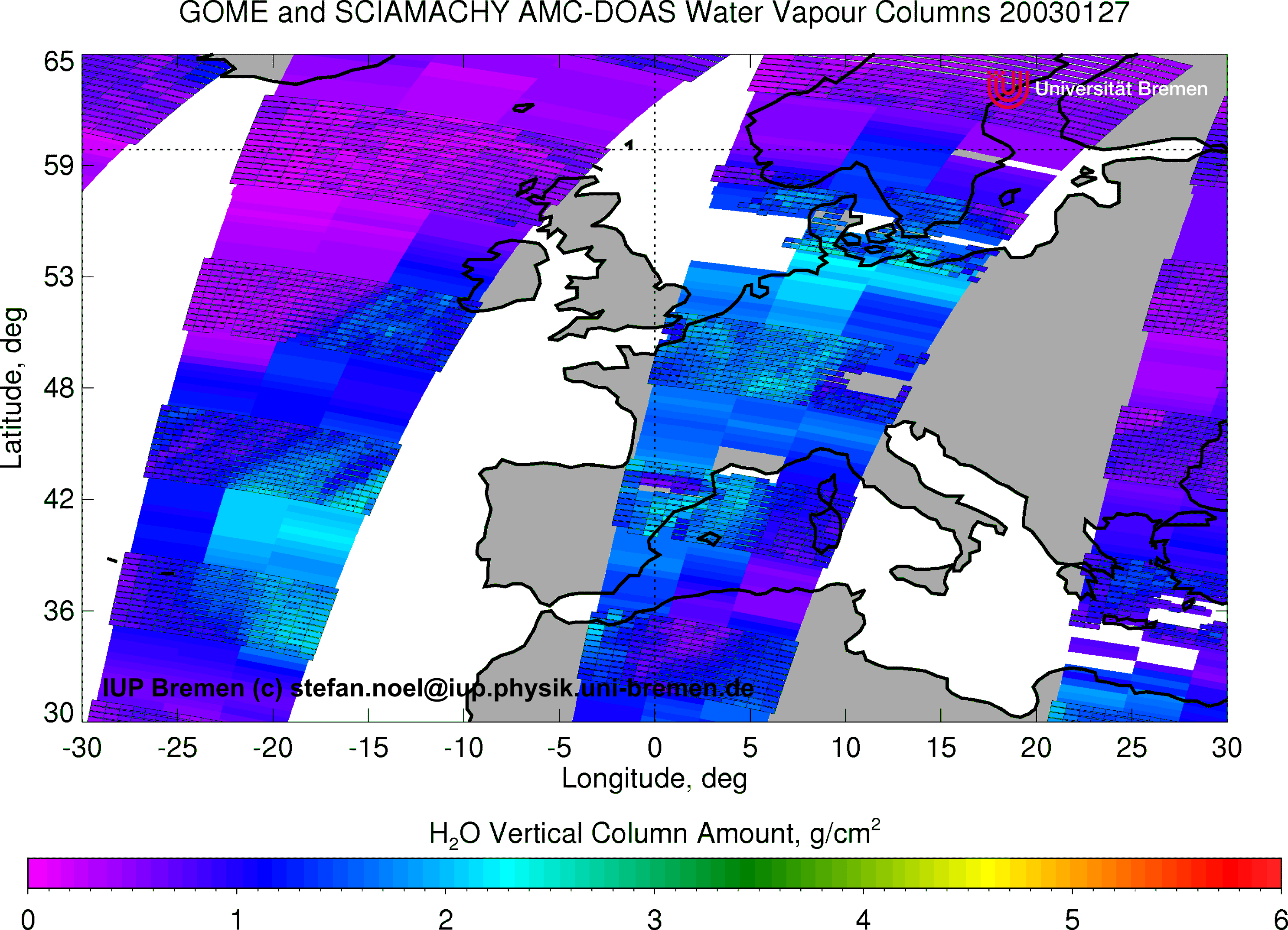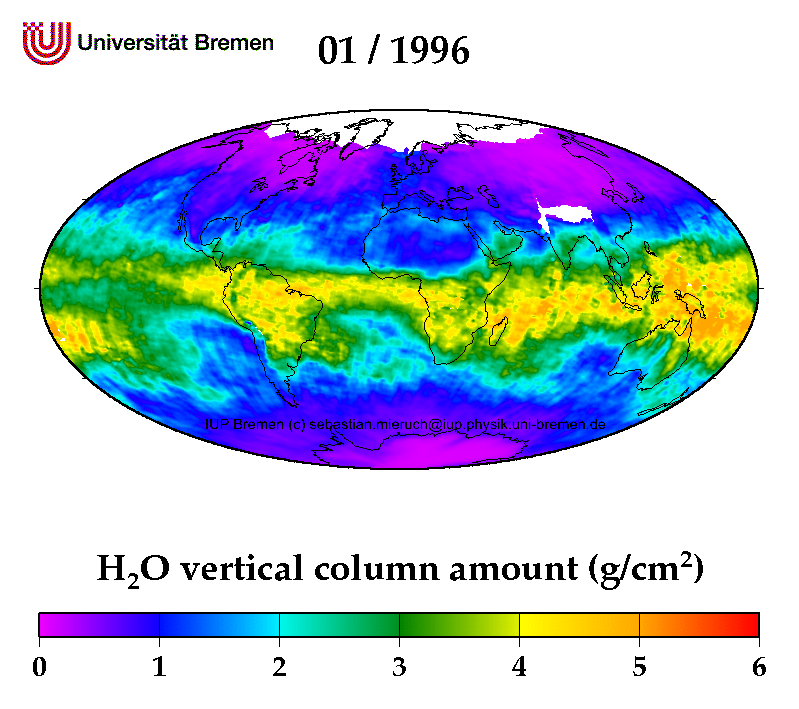
AMC-DOAS
DOAS
SCIAMACHY
GOME
Water Vapour Retrieval using AMC-DOAS
Introduction
Retrieval Method
Data Products
Data Access
References
Contact
This is the AMC-DOAS main page.
The AMC-DOAS algorithm is based on a modified DOAS approach
as it uses the information contained in the differential absorption
structures. The main differences to "standard" DOAS are:
The size of the air mass correction factor can be used a criterion for the quality of the H2O data product. In the ideal case, i.e. if the atmospheric conditions used in the model calculations match the real conditions, the air mass correction factor should be 1. In the presence of clouds, only the atmosphere above the clouds can be probed by the instrument, so the effective amount of both O2 and H2O seen by the instrument is smaller than the amount used in the model calculations. The air mass factor correction would then try to compensate for this. In this case the correction factor would be smaller than 1.
If the air mass correction factor deviates too much from 1, this is an indication that the conditions of the reference atmosphere differ to much from reality. In this case the retrieved H2O columns are considered to be unrealistic.
In practice, it could be shown that data retrieved with air mass correction factors smaller than 0.8 are unreliable. Therefore, these data have been omitted from the distributed data products. In addition, measurements performed at high solar zenith angles (larger than 88 deg) have been excluded.
Details about the AMC-DOAS method can be found e.g. in Noël et al. (2004).
There is also an Algorithm Description Document available.
SCIAMACHY and GOME H2O total columns over Europe for 27 Jan 2003.
The smaller SCIAMACHY ground pixels are marked by boxes.
Intercomparisons between AMC-DOAS results based on GOME and SCIAMACHY measurements showed a good agreement (Noël et al., 2006, 2007). It is therefore possible to generate a combined GOME/SCIAMACHY water vapour climatology which is useful for climatological trend analysis applications.
AMC-DOAS
water vapour total column data have been derived for all GOME data from
July 1995 until December 2004 (with reduced coverage after June 2003).
All available SCIAMACHY data since August have been processed. The analysis is ongoing, have a look at the SCIAMACHY DOAS nadir browser for most recent results.
Current data product version is 1.0. Click here for a list of changes. You may also download the Product Specification Document.
Access to all data is possible under certain conditions; click here for details.
If you are interested in more information on
AMC-DOAS water vapour, please contact Stefan
Noël.
Author of this page: Stefan Noël


©2008
This is the AMC-DOAS main page.
 Introduction
Introduction
Water vapour is one of the most
important atmosphere constituents. Most of it is located in the
troposphere close to the surface of the Earth. Especially, water vapour
is the major greenhouse gas; without the natural greenhouse effect due
to water vapour life on Earth as we know it would not be possible. The
knowledge about the global distribution of water vapour is a relevant
input quantity for atmospheric models aiming to predict weather or
climate.
The probably most accurate tropospheric water vapour measurements are performed by radio sondes. However, radio sondes can only provide very localized snapshots of the atmospheric conditions, and the distribution of radio sonde measurement sites over the Earth is rather inhomogeneous and considerably sparse especially over the oceans and in the southern hemisphere.
Only satellite measurements using remote sensing techniques can provide water vapour data on the global scale, but they are usually limited in spatial and/or temporal coverage and resolution. Different sensors using different spectral regions and viewing geometries and various retrieval methods have been developed to derive water vapour concentrations from satellite data.
The Air Mass Corrected Differential Optical Absorption Spectroscopy (AMC-DOAS) is a method to retrieve total water vapour column amounts from spectral measurements in the visible wavelength region around 700 nm. Because data in the visible spectral range are analysed, the AMC-DOAS method is only applicable to measurements on the dayside and to (almost) cloud-free ground scenes. A significant advantage of the AMC-DOAS method is that the derived water vapour columns do not depend on additional external information, like a calibration using radio sonde data which is often used in the microwave spectral region. The AMC-DOAS water vapour columns therefore provide a completely independent data set.
The probably most accurate tropospheric water vapour measurements are performed by radio sondes. However, radio sondes can only provide very localized snapshots of the atmospheric conditions, and the distribution of radio sonde measurement sites over the Earth is rather inhomogeneous and considerably sparse especially over the oceans and in the southern hemisphere.
Only satellite measurements using remote sensing techniques can provide water vapour data on the global scale, but they are usually limited in spatial and/or temporal coverage and resolution. Different sensors using different spectral regions and viewing geometries and various retrieval methods have been developed to derive water vapour concentrations from satellite data.
The Air Mass Corrected Differential Optical Absorption Spectroscopy (AMC-DOAS) is a method to retrieve total water vapour column amounts from spectral measurements in the visible wavelength region around 700 nm. Because data in the visible spectral range are analysed, the AMC-DOAS method is only applicable to measurements on the dayside and to (almost) cloud-free ground scenes. A significant advantage of the AMC-DOAS method is that the derived water vapour columns do not depend on additional external information, like a calibration using radio sonde data which is often used in the microwave spectral region. The AMC-DOAS water vapour columns therefore provide a completely independent data set.
Example for
an
Earthshine spectrum measured by the GOME
instrument (channel
4).
The AMC-DOAS fitting window is marked.
The AMC-DOAS fitting window is marked.
(Click to enlarge)
 Retrieval Method
Retrieval Method
The AMC-DOAS algorithm is based on a modified DOAS approach
as it uses the information contained in the differential absorption
structures. The main differences to "standard" DOAS are:- Saturation effects arising from highly structured differential spectral features which are not resolved by the measuring instrument are accounted for.
- O2 absorption features are fitted in
combination with
H2O to determine an air mass correction factor which
compensates to some degree for insufficient knowledge of the background
atmospheric characteristics, especially cloudiness, and for geometrical
aspects like scan angle dependencies.
The size of the air mass correction factor can be used a criterion for the quality of the H2O data product. In the ideal case, i.e. if the atmospheric conditions used in the model calculations match the real conditions, the air mass correction factor should be 1. In the presence of clouds, only the atmosphere above the clouds can be probed by the instrument, so the effective amount of both O2 and H2O seen by the instrument is smaller than the amount used in the model calculations. The air mass factor correction would then try to compensate for this. In this case the correction factor would be smaller than 1.
If the air mass correction factor deviates too much from 1, this is an indication that the conditions of the reference atmosphere differ to much from reality. In this case the retrieved H2O columns are considered to be unrealistic.
In practice, it could be shown that data retrieved with air mass correction factors smaller than 0.8 are unreliable. Therefore, these data have been omitted from the distributed data products. In addition, measurements performed at high solar zenith angles (larger than 88 deg) have been excluded.
Details about the AMC-DOAS method can be found e.g. in Noël et al. (2004).
There is also an Algorithm Description Document available.
 Data Products
Data Products
The AMC-DOAS retrieval method has been successfully applied to
measurements of GOME (Noël
et al., 1999)
and SCIAMACHY (Noël
et al., 2004) . Because the ground pixel size of
SCIAMACHY is typically much
smaller than for GOME (30 km x 60 km compared to 40 km x 320 km), the
probability for cloud-free scenes is much higher for SCIAMACHY. Global
coverage is achieved for SCIAMACHY nadir measurements in 6 days, for
GOME in 3 days.
SCIAMACHY and GOME H2O total columns over Europe for 27 Jan 2003.
The smaller SCIAMACHY ground pixels are marked by boxes.
(Click to enlarge)
AMC-DOAS water vapour results have been compared with various
independent data, including
measurements of the Special Sensor
Microwave Imager (SSM/I) over ocean, assimilated global water vapour
data provided by the European Centre for Medium-Range Weather Forecast
(ECMWF) and in-situ radio sonde data. These intercomparisons revealed
in general a good agreement
between the different data sets, but AMC-DOAS water vapour columns are
typically slightly (~0.2 g/cm2) lower than e.g. SSM/I and
ECMWF data. This is most likely caused by the exclusion of too cloudy
(and thus moist) scenes in the AMC-DOAS data. In all cases a large
scatter in the data (~0.5 g/cm2) was observed which can be
mainly attributed to the large spatial and temporal variability of
water vapour (see e.g. Noël
et al., 2005, for details).Intercomparisons between AMC-DOAS results based on GOME and SCIAMACHY measurements showed a good agreement (Noël et al., 2006, 2007). It is therefore possible to generate a combined GOME/SCIAMACHY water vapour climatology which is useful for climatological trend analysis applications.
The
combined GOME (1996-2002) and SCIAMACHY (2003-2006) water vapour data
set (monthly means).
(Click to enlarge)
The AMC-DOAS method has also been applied to GOME-2 data. Click here for first results or have a look at the Noël et al. (2008) paper.
(Click to enlarge)
The AMC-DOAS method has also been applied to GOME-2 data. Click here for first results or have a look at the Noël et al. (2008) paper.
 Data Access
Data Access
AMC-DOAS
water vapour total column data have been derived for all GOME data from
July 1995 until December 2004 (with reduced coverage after June 2003). All available SCIAMACHY data since August have been processed. The analysis is ongoing, have a look at the SCIAMACHY DOAS nadir browser for most recent results.
Current data product version is 1.0. Click here for a list of changes. You may also download the Product Specification Document.
Access to all data is possible under certain conditions; click here for details.
 References
References
- S. Noël, M. Buchwitz, H. Bovensmann, R. Hoogen, and J. P. Burrows, Water vapour retrieval from GOME data, Proc. European Symposium on Atmospheric Measurements from Space, vol. 1, 375-381, 1999. (PDF file, ca. 284 kB)
- S. Noël, M. Buchwitz, H. Bovensmann, R. Hoogen, and J. P. Burrows, Atmospheric Water Vapor Amounts Retrieved from GOME Satellite Data, Geophys. Res. Lett., vol. 26(13), 1841-1844, 1999. (PDF file, ca. 211 kB)
- S. Noël, H. Bovensmann, J. P. Burrows, Water vapour retrieval from GOME data including cloudy scenes, Proc. ENVISAT/ERS Symposium, Gothenburg, 2000. (PDF file, ca.1.7 MB)
- S. Noël, M. Buchwitz, H. Bovensmann, and J. P. Burrows, Retrieval of Total Water Vapour Column Amounts from GOME/ERS-2 Data, Adv. Space Res., 29(11), 1697-1702, 2002. (PDF file, ca. 284 kB)
- S. Noël, M. Buchwitz, and J. P. Burrows, First retrieval of global water vapour column amounts from SCIAMACHY measurements, Atmos. Chem. Phys., 4, 111-125, 2004. (PDF file at ACP web site, ca. 22.6 MB)
- S. Noël, M. Buchwitz, H. Bovensmann, and J. P. Burrows, SCIAMACHY water vapour retrieval using AMC-DOAS, Proc. ENVISAT Symposium, Salzburg, Austria, 6-10 September, 2004 (ESA SP-572), 2005. (PDF file, ca. 1.4 MB)
- S. Noël, M. Buchwitz, H.
Bovensmann,
and J. P. Burrows, Validation of SCIAMACHY AMC-DOAS water vapour
columns,
Atmos. Chem. Phys., 5, 1835-1841, 2005.
(PDF
file at ACP web site, ca. 3.6 MB)
- S. Noël, S. Mieruch, M.
Buchwitz, H.
Bovensmann, and J. P. Burrows, GOME and SCIAMACHY global water vapour
columns, Proc. of the First ‘Atmospheric Science Conference’, ESRIN,
Frascati, Italy, 8–12 May 2006 (ESA SP-628), 2006. (PDF file, ca. 1.4 MB)
- S. Noël, S. Mieruch, H. Bovensmann, and J. P. Burrows, A combined GOME and SCIAMACHY global water vapour data set, Proc. ENVISAT Symposium, Montreux, Switzerland, 23–27 April 2007 (ESA SP-636), 2007. (PDF file, ca. 9.6 MB)
- S. Mieruch, S. Noël, H. Bovensmann and J. P. Burrows, Analysis of global water vapour trends from satellite measurements in the visible spectral range, Atmos. Chem. Phys., 8, 491-504, 2008. (PDF file, ca. 13 MB)
- S. Noël, S. Mieruch, H. Bovensmann and J. P. Burrows, Preliminary results of GOME-2 water vapour retrievals and first applications in polar regions, Atmos. Chem. Phys., 8, 1519-1529, 2008. (PDF file, ca. 9.7 MB)
 Contact
Contact
If you are interested in more information on
AMC-DOAS water vapour, please contact Stefan
Noël. Author of this page: Stefan Noël


©2008



